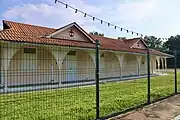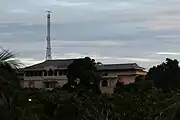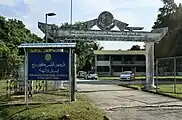| Istana Darul Hana | |
|---|---|
.jpg.webp) Istana Darul Hana in 2022 | |
| General information | |
| Address | Jalan Darul Hana |
| Town or city | Bandar Seri Begawan |
| Country | Brunei |
| Coordinates | 4°52′47″N 114°55′43″E / 4.8796904°N 114.9287151°E |
| Year(s) built | 1950–1951 |
| Opened | 10 May 1951 |
| Technical details | |
| Material | concrete and cement |
| Size | 6 acres (2.4 ha) |
The Istana Darul Hana (English: Darul Hana Palace)[1] is one of the few remaining palaces in Brunei which notably,[2] is the former residence of Omar Ali Saifuddien III from 1951 to 1987. The palace is located on a hill at Kilometer 3 of Jalan Tutong in Kampong Tumasek, Brunei-Muara District, Brunei.[3][4] It is sometimes referred to as Istana Lama.[5]
Name
The English translation of the two Arabic phrases "Darul Hana" is "Happy Country," and it has no religious connotations.[6] It can also be translated to "peace and tranquility."[7]
Design and construction
Istana Darul Hana is built alongside and facing the Brunei River.[8] It was first constructed from concrete and cement in 1950, and later completed in 1951.[9] It covers an estimated area of 6 acres (2.4 ha).[3] A few notable aspects of the palace is its water fountain,[10] Show Room,[11] Balai Singgahsana,[12] and Regalia House.[13] Since its completion, the palace has seen expansions and additions. This is the first palace constructed completely of cement.[14] According to a 1974 report at the palace, "Extensions to Princesses' Apartments and Remodelling of the Store Roof" were noted.[15]
History
Upon its completion in 1951, Sultan Omar Ali Saifuddien III would soon make it his official residence later year on 10 May.[3] During its service period, it was regularly used to celebrate or commemorate royal engagements.[16] Hassanal Bolkiah also received his early education by private tuition at the palace prior to attending top schools in both his country and Malaysia.[17][18]
In order to compel the Sultan of Brunei to proclaim a Federal State of North Kalimantan during the 1962 Brunei revolt, the rebels of the Brunei People's Party had planned and attempted to kidnap the Sultan, but were not successful.[19] His Majesty and his family were still at the palace on the night of the uprising, joined by a number of state dignitaries and six police officers.[20]
Later on 29 July 1965, the wedding ceremony between then Prince Hassanal Bolkiah and Princess Saleha were held at the palace.[21] The palace would once again be used for another national event which is the Sultan Omar Ali Saifuddien III's abdication in 1967, and its rule be transferred to his son, then Prince Hassanal Bolkiah.[22][23] Later in October 1969, the palace was used for the wedding of Princess Masna and Pengiran Anak Abdul Aziz.[24]
It will continue be used until the completion of the new Istana Nurul Iman around 1987.[3] As of 2009, it is one of the only three remaining palaces that still exists in the country, with the other two being Istana Nurul Iman and Istana Nurul Izzah.[2]
Gallery
 Section of the palace in 1959
Section of the palace in 1959 The palace's surau
The palace's surau Northwestern face of the palace
Northwestern face of the palace Southeastern gate to the palace
Southeastern gate to the palace The palace's police housing
The palace's police housing
See also
References
- ↑ Brunei Political, Constitutional System and Procedures Handbook - Strategic Information and Regulations. Lulu.com. 2017-12-24. p. 170. ISBN 978-1-5145-1648-5.
- 1 2 Sidhu, Jatswan S. (2009-12-22). Historical Dictionary of Brunei Darussalam. Scarecrow Press. p. 175. ISBN 978-0-8108-7078-9.
- 1 2 3 4 Abdul Latif, Adanan (2008). "Istana-Istana Di Brunei" (PDF). Brunei History Centre. p. 23-24.
- ↑ Brunei (1953). Annual Report. H.M. Stationery Office. p. 135.
- ↑ Negeri, Direktorat Jenderal Kerja Sama ASEAN-Kementerian Luar (2015-03-01). Majalah Masyarakat ASEAN Edisi 7: Membidik Peluang MEA (in Indonesian). Direktorat Jenderal Kerja Sama ASEAN - Kementerian Luar Negeri. p. 45.
- ↑ Adhar, Zaid (2020-12-09). "'Sarawak Darul Hana': Hentikan manipulasi!". Harakahdaily. Retrieved 2023-11-26.
- ↑ Mohd, Roji Kawi (14 November 2017). "Opening of RM35m Darul Hana Bridge over Sungai Sarawak". New Straits Times. Archived from the original on 24 June 2021. Retrieved 22 December 2023.
- ↑ Guides, Rough (2023-06-01). The Rough Guide to Malaysia, Singapore & Brunei (Travel Guide eBook). Apa Publications (UK) Limited. ISBN 978-1-83905-928-5.
- ↑ Latiff (Haji), Adanan Haji Abdul (2011). Bangunan ristaan (in Malay). Dewan Bahasa dan Pustaka Brunei, Kementerian Kebudayaan, Belia dan Sukan. p. 10. ISBN 978-99917-0-770-9.
- ↑ Office, Great Britain Colonial (1958). Brunei. H.M. Stationery Office. p. 210.
- ↑ Brunei (1977). Annual Report on Brunei. p. 459.
- ↑ Puteri sulung (in Malay). Dewan Bahasa dan Pustaka, Kementerian Kebudayaan, Belia dan Sukan. 1996.
- ↑ Brunei (1966). Annual Report on the Social and Economic Progress of the People of Brunei. Printed at the Brunei Press. p. 181.
- ↑ Kampong Ayer: warisan, cabaran, dan masa depan : kumpulan esai yang pernah diterbitkan 1970-1996. Akademi Pengajian Brunei, Universiti Brunei Darussalam, Negara Brunei Darussalam. 1996. p. 92.
- ↑ Brunei (1974). Anggaran-Anggaran hasil dan perbelanjaan: Estimates of revenue and expenditure (in Malay). p. 169.
- ↑ Brunei (1967). Annual Report on Brunei. Printed at the Brunei Press. p. 221.
- ↑ Brunei Darussalam in Brief. Broadcasting & Information Department, Ministry of Culture, Youth and Sports. 1986. p. 8.
- ↑ Asia, Inc: The Region's Business Magazine. Manager International Company. 2004. pp. BH-6.
- ↑ Gunaratna, Rohan; Kam, Stefanie Li Yee (2016-06-22). Handbook Of Terrorism In The Asia-pacific. World Scientific. p. 146. ISBN 978-1-78326-997-6.
- ↑ Melayong, Muhammad Hadi bin Muhammad (2009). Memoir seorang negarawan (in Malay). Pusat Sejarah Brunei, Kementerian Kebudayaan, Belia dan Sukan. p. 100. ISBN 978-99917-34-69-9.
- ↑ "Istiadat Muleh 3 Hari Di-Langsongkan Dengan Selama-nya" (PDF). Pelita Brunei. 1965-08-04. p. 1. Retrieved 2023-10-26.
- ↑ Conference, Borneo Research Council (Williamsburg, Va ) (2000). Borneo 2000: Politics, history & development. Universiti Malaysia Sarawak. p. 189. ISBN 978-983-9257-03-8.
{{cite book}}: CS1 maint: multiple names: authors list (link) - ↑ al-Sufri (Haji), Awang Mohd Jamil (2002). Survival of Brunei: A Historical Perspective. Brunei History Centre, Ministry of Culture, Youth and Sports. p. 78. ISBN 978-99917-34-18-7.
- ↑ "Istiadat2 Menerima Tanda Dan Pertunangan Di-Raja" (PDF). Pelita Brunei. 1969-10-29. p. 1. Retrieved 2023-10-26.